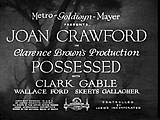 Possessed (1931) MGM/UA Home Video.
Possessed (1931) MGM/UA Home Video.
In Possessed, Joan is quite literally possessed to succeed. But coming from a small factory town, she has little to work with: "All I've got is my looks and my youth and whatever it is about me that fellows like." When she sets off for the big city, she promptly meets a man who gives her some quick pointers: "When you meet a man, never look into his eyes. Take a peek at the pocket book" and she takes this advice to heart. She soon finds herself a Park Avenue lawyer played by Clark Gable, who sets her up in a luxurious apartment. It's quite clear they can't keep their hands off one another. But Gable is set for political office and Crawford could be seen as a liability. During a meeting with his political cohorts, he says he'll marry her. But that won't do: "They'd say you married [her] to clear your skirts before election. It'll ruin you." Crawford overhears the conversation, and in one of the first great sacrifices of a career filled with sacrifices, Crawford gives up Gable, pretending that she still loves a hick from her home town: "I'm common and I like it and that's the level I'm going back to."
Grand Hotel (1932) MGM/UA Home Video.
In Grand Hotel, Joan plays a secretary not adverse to earning a few extra dollars by playing a little hanky panky with high rollers on the side. The movie is highly overrated and only really comes alive when Crawford is on the screen (some would argue for Garbo also). She flirts with John Barrymore, who plays a jewel thief, but you'll find no fireworks there, unlike the Crawford/Gable pictures. The MGM movies that were designed as simple star vehicles actually have weathered the years better than the big prestigious movies like Grand Hotel.
Dancing Lady (1933) MGM/UA Home Video.
In Dancing Lady, she once again plays a woman with lower-class origins who has the yearnings for the big time. This time, she is a woman of principles. She won't just latch onto the first millionaire who makes a play for her. Her real love is dancing, and that's what she lives for. Joan is performing in a striptease number with 20 other girls at a burlesque revue when Franchot Tone and his Park Avenue cronies go slumming. And when the burlesque revue gets raided by the police and the girls are packed into paddy wagons for a trip downtown, Tone follows, leering at the women, who have conveniently been packed off to court in just their skivvies. When Tone makes his play for Joan--"I'm your break. I'm the chance of a lifetime, Janie. You'd better take me up"-- she refuses him. Tired of penny-ante "burly-cue" revues, she sets off for the big time: "I'm through dreaming. I'm gonna start doing. I'm going up where it's art. Uptown." But only through Tone's slick-dealing with the show's producer (unbeknownst to Joan) does she get her foot in the door and meet the big-time director played by, you guessed it, Clark Gable. She convinces him that she wants to dance "more than anything in the world." And her road to the top is assured, if it just weren't for that pesky Tone, who has other plans for Joan.
Sadie McKee (1934) MGM/UA Home Video.
In Sadie McKee, Joan just wants to be happy with the man she loves, even though he's "just a little bit crooked" and doesn't care "how tough things are." She accompanies him to the big city, where they shack up together. But a sultry singer talks him into joining her act, seducing him like a young Mae West ("I got warm just listening to you," she says after hearing him sing), and he leaves poor Joan waiting at the marriage license office, abandoned in the big city. With no means of support, a friend gets her a job at a hoochy coochy parlor as a dancer. Dressed in skimpy bra and panties, she dances around the joint, throwing roses and getting pawed by lust-crazed patrons. "I wished they'd keep their filthy hands off me," she says. "You'll get used to it," a friend says. After a rich, habitually drunken customer (Edward Arnold) asks to see her after the show ("What does he want?" she asks. "Baby, he wants a souvenir," says one of the show girls.) she cautiously joins his table, only to find Franchot Tone, who immediately suspects the worst "Are you gonna let this little chiseller marry you for your money?" Unlike her other roles she isn't golddigging. She would happily have just settled down with her true love, but with Franchot Tone believing the worst of her, she does exactly what he warns her against and marries Arnold. And only after plenty of suffering, including curing Arnold of alcoholism, the road is paved for true happiness. If there is a message in her movies, it's that you can't achieve true love until you've suffered terribly first.
Chained (1934) MGM/UA Home Video.
Chained places Joan in the role of a working woman who falls in love with a millionaire over twenty years her senior. But he's married and his wife won't give him a divorce. So he sends Joan away on a voyage so she can think about whether she wants to be a kept woman. And poor Joan promptly meets a rich rancher from Argentina, none other than Clark Gable. And, oh, what a decision Joan must make. Chained is a prime example of MGM gloss, as Crawford goes through a wardrobe change every 30 seconds. The camera plays to her face, capturing her in one luxurious image after another. The movie gives her another chance to play the "I thought I'd rather have you hate me than love me" angle as she resigns herself to just grin and bear it with her senior citizen sugar daddy, while Gable stews on the Pampas. Chained marks the end of this early phase of her career, suggesting the all-glamour and no-substance roles that MGM would place her in throughout the late '30s.

























